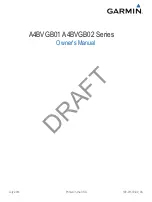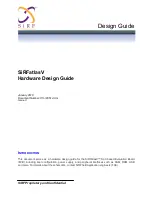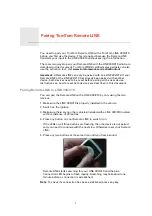
4.1. *UNIT’S ID
are also defined in order to gain remote access to the unit.
The sections on this chapter marked with an * are essential to
every configuration.
Note:
This chapter is a complement of the
TAIP reference
chapter and
vice versa. A lot of times will be expected for the reader to con-
tinue the given explanation on the TAIP reference when making
reference to a TAIP message/command.
Note:
.
4.1
*Unit’s ID
This parameter is only meaningful to the AVL software which is going to
(*)Essential configuration
receive reporting messages from the unit. It is not necessary for the unit to
work but it may necessary for making a
Getting Started
test with an AVL
software.
The unit’s ID is a 10 characters maximum string containing any charac-
ter but ‘
;
’, ‘
<
’ or ‘
>
’. The initial value is
0000
.
The ID is used every time the unit sends a TAIP report message (
EV
or
ET
) by adding the postfix “
;ID=UNIT’S ID
” to the message. This postfix
gives the AVL software information on who is sending the report.
The AVL software may use the
>
QID
<
query to ask for the unit’s ID once
and only a new TCP connection is established. The “
;ID=
” postfix may be
then eliminated from the unit’s reports with the
RM
message, this saves a
few consumption bytes.
Refer to the TAIP reference for more information. The ID setting takes
the following form for an unit’s ID
UNIT-0015
:
>
SIDUNIT-0015
<
4.2
*Enabling the unit on GSM and GPRS
The GSM registration as well as the GPRS attachment (getting a valid
(*)Essential configuration
IP address from the cellular operator) is automatically done by the unit
all the time. This means that whenever there is GSM and GPRS network
availability and the unit is correctly configured it is going to be GPRS-
attached (The green On Line LED
solid
or
blinking
) and GSM-registered
(The orange signal LED
blinking
or
off
).
For this, two parameters are
71
Summary of Contents for Antares SB
Page 1: ......
Page 2: ...Antares SB TM GSM User s Manual FW 5 21 Digital Communications Technologies April 15 2008...
Page 37: ...2 1 POWER SUPPLY 35...
Page 38: ...2 1 POWER SUPPLY 36...
Page 42: ...2 5 CONNECTION DIAGRAMS 40...
Page 141: ...6 Unit s TAIP reference...
Page 191: ...6 32 XADM DIAGNOSTIC MESSAGE 189...
Page 228: ......
Page 229: ......














































